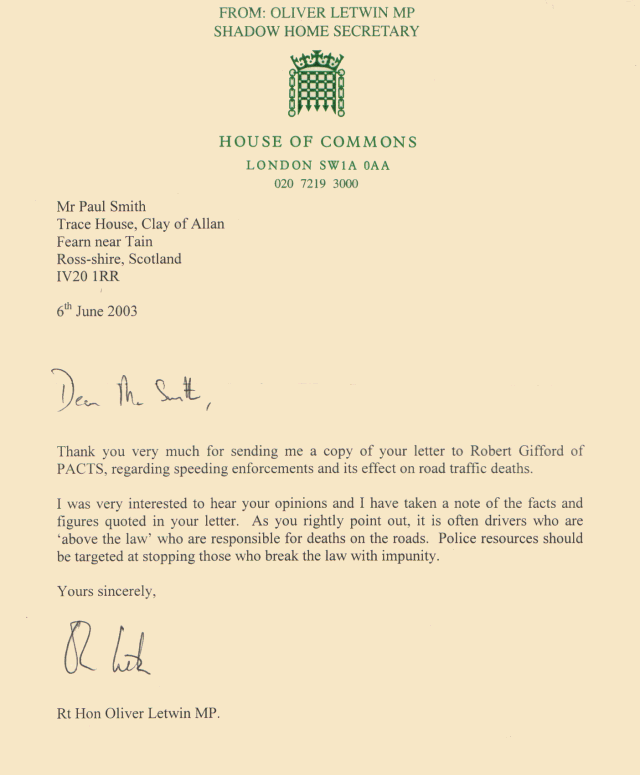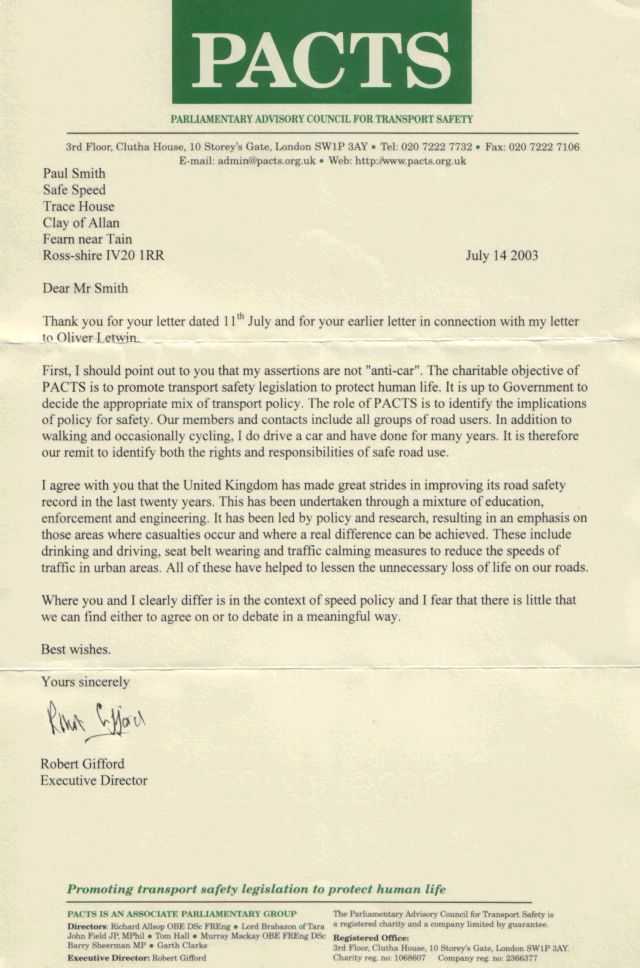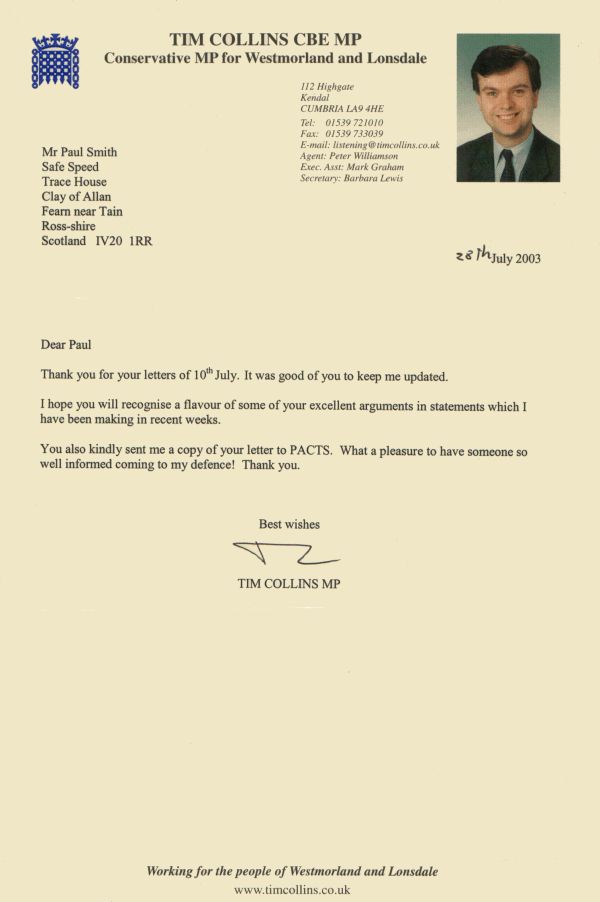
1st
June 2003
Robert
Gifford
PACTS
3rd
Floor Clutha House
10
Storey’s Gate
London
SW1P
3AY
Dear
Mr Gifford,
Your
letter to Oliver Letwin MP
I see
displayed on the Internet at http://www.pacts.org.uk/Letwin.htm
a copy of a letter you sent to Oliver Letwin MP on May 7th. Your letter
portrays an entirely false view of the facts about the relationship between
speed limit enforcement and road safety.
You
say:
Speed,
whether excess (breaking the posted limit) or inappropriate (driving too
fast for the conditions), is a contributory factor in one in three road
deaths. That amounts to about 1,100 deaths per year. Many of these deaths
would have been avoided if drivers had remained within the speed limit.
How very
deliberately misleading! I observe the following errors and distortions:
-
It is
certainly not proven that one in three road deaths have “speed” as a contributory
factor. The majority of figures available place this at 15% or under.
-
It is
misleading (although I accept difficult to avoid) to lump together excessive
and inappropriate speed. Best estimates suggest that two thirds of these
accidents take place within the speed limit and are therefore out of reach
of speed enforcement.
-
Drivers
who will always ignore any speed enforcement measures cause a significant
proportion of these deaths. They might be drunk, driving stolen cars, criminals
escaping from the scene of a crime, police drivers on emergency calls,
or otherwise driving recklessly or dangerously. It is entirely false to
imply that these groups might somehow be rendered safe by speed enforcement.
-
The word
“many” in the last sentence is intended to imply a large number, when the
reality might well be a very small number.
-
No amount
of enforcement will produce 100% compliance with speed limits, so enforcement
will always fall short of eliminating deaths contributed to by excessive
speeds.
So more
realistically we might get: 550 “speed related” deaths per year, of which
one third (180) were in excess of the speed limit, of which half (90) were
caused by drivers who were otherwise obeying legal requirements, of which
half (45) might have been avoided by doubling speed limit enforcement.
But
wait a minute, since we started installing speed cameras in 1993 the long
term downwards trend in the UK fatal accident rate has stalled completely
and looks about set to rise when 2002 figures are announced shortly. Do
you not find it remarkable that despite massive increases in speed enforcement
over the last decade we've seen no improvement in fatal accident figures?
Of
course, there are good reasons that our flawed policy has failed to deliver
reductions in road deaths:
Firstly,
exceeding a speed limit alone is an insignificant accident causation factor.
TRL 323 has excessive speed as a definite causation factor in just 4.5%
of accident reports. In some of those reports there will have been obvious
causes of both the speed and the accidents; recklessness, escaping criminals,
drunks and so on. Two of the reports were suicide attempts, and although
we are not told if they were also excess speed accidents, they probably
were. You might recall that TRL323 lumps together excessive and inappropriate
speeds, so of course any remaining percentage needs to be reduced by perhaps
67% to account for the proportion of accidents that take place within the
speed limit.
Secondly,
increases in speed enforcement have some negative effects on road safety.
I'll quote to you five major effects that are inadequately researched.
At lower speeds
driver concentration may be reduced. Impacts
on “drivers’ priorities” where at a critical instant they might be
more concerned about compliance with a legal speed limit instead of an
unseen dangerous situation developing ahead. Risk compensation: Where
a driver at a lower speed may unknowingly preserve risk values by driving
closer or more aggressively. Attitude effects: Where increasing
the restrictions on a driver may make him care less about his driving in
general. Traffic displacement: where an increase in speed enforcement
on one route causes drivers to chose an alternative route which is more
dangerous. I maintain a list of 17 factors that may cause danger to be
increased when automated speed enforcement is deployed. All of them are
inadequately researched.
Thirdly,
the supposed science supporting the so-called speed accident relationship
fails to establish a causal link between speed and accidents. This isn't
surprising, because no such causal link exists, yet even the TRL fail to
come clean about it, and persist in claiming that reducing speeds will
reduce accidents with no adequate supporting evidence. You might be interested
to read correspondence with the TRL's Chief Executive about it here: http://www.safespeed.org.uk/trl.html.
Fourthly,
rigid speed enforcement played no part in establishing Britain's roads
as the safest in the world. In fact over the last decade we have lost much
ground to some other European countries where speed enforcement has not
become an obsession.
Fifthly,
most accidents take place in areas of danger. In fact it is hard to imagine
an accident taking place in the absence of road hazards. Billions of times
each day drivers slow to appropriate speeds and negotiate road hazards
safely at speeds both above and below the speed limit. Yet speed enforcement
in general has its greatest effects exactly where dangers are least: on
open roads away from hazards. So the greatest effects of enforcement tend
to take place where road dangers are least.
You
also said:
Figures
from the report evaluating the first two years of eight of the speed camera
partnerships published in February 2003 concluded that deaths and serious
injuries had fallen by 35% on roads where speed cameras had been in operation,
equating to about 280 people.
What a
very strange document that is! It is untrustworthy spin for the following
reasons:
It
is highly remarkable that the document does not include any fatal accident
figures, and prefers the much vaguer “killed and seriously injured”. One
assumes that this is because the deaths figures did not support the case
presented.
The
document ignores the possibility of site level regression to the mean effects,
save to include:
We
could not obtain data for the before period for individual sites other
than at camera sites. It was therefore not possible to check fully for
regression to the mean at the site level.
Since
it is clearly impossible to calculate properly qualified results without
fully allowing for regression to the mean effects, this demonstrates with
absolute clarity that the authors never had the data required to support
the reports’ headline conclusions.
Based
on all the above, I expect you will be revising your stance in the interests
of real road safety based on truth. I look forward to hearing from you.
Yours
sincerely
Paul
Smith
cc:
The
Right Honourable Oliver Letwin MP
House
of Commons
Westminster
London
SW1A 0AA |




